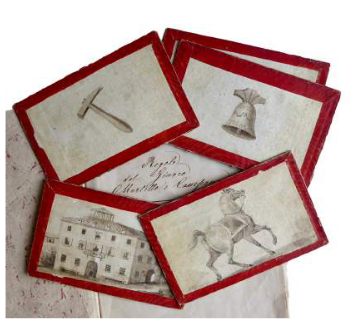In part II, 'Reflection & Self Improvement,' we take note of all the things that have become primary to our new routines, such as homeschooling, but also all the pastimes that distract us during times like these: painting, gardening, cooking, and yes, even book collecting in a french guide to collecting printed in 1756—although that one, I’m told, has been sold. Keeping a diary or a commonplace book has become popular again, and there are a few examples in this catalogue. A pocket journal of religious devotions handwritten in 1808, perhaps by someone living in London’s East End, is particularly moving.
'Home Entertainment,' in the form of riddles, puzzles, and games, frames the catalogue’s third section. Again, incredibly apropos to this moment in history, as so many struggle to fill their time at home, with or without children. Pictured below is a handmade version of a popular card game ca. 1800 that caught my eye with its pretty watercolor illustrations of the cards. It also includes a handwritten rule book, stitched in pattern paper wrappers.


















